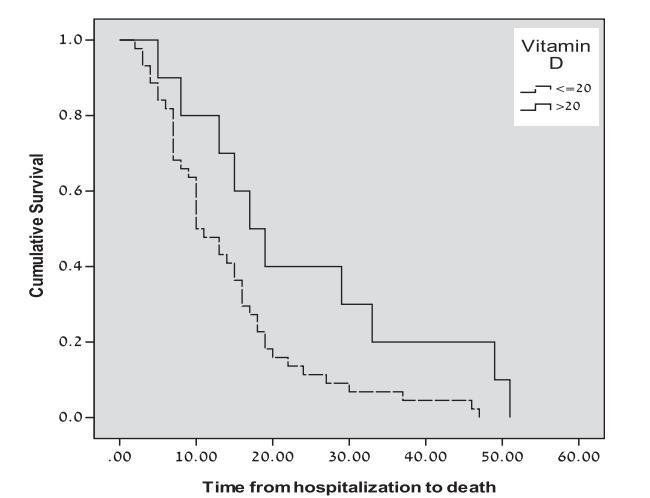Seniors on mechanical ventilation having very low vitamin D died sooner
Vitamin D deficiency is associated with poor outcomes and increased mortality in severely ill patients.
QJM. 2012 Jul;105(7):633-9. doi: 10.1093/qjmed/hcs014. Epub 2012 Feb 12.
Arnson Y, Gringauz I, Itzhaky D, Amital H. hamital@netvision.net.il
Department of Medicine B, Sheba Medical Center, Tel-Hashomer 52621, Israel.
BACKGROUND:
Vitamin D plays a seminal role in many homeostatic mechanisms.
In this study, we assessed the correlation between circulating vitamin D levels and mortality rates in critically ill patients.
METHODS:
All patients admitted to the intensive care units (ICUs) and internal medicine wards in a university-based hospital that required mechanical ventilation were admitted. Data collected included the underlying disease, basic hematological and biochemical blood test results, APACHE II scores and serum 25-hydroxyvitamin D [25(OH)D] levels. The primary end point was defined as all-cause mortality within 60 days from admission or from acute deterioration.
RESULTS:
Between December 2008 and June 2009, 130 patients were enrolled. Average vitamin D concentration was 14.04?±?6.9?ng/ml; 107 patients were vitamin D deficient (20?ng/ml (P?PDF is attached at the bottom of this page
Death rates for average
12 ng (category < 20) = - - - - - -
25 ng (category >20) = ** _

Strange: paper states overall mortality rate of 44% within 60 days of hospitalization for all patients.
Yet the graph seems to indicate 100% death rate within 60 days
Expect that seniors with a good level of vitamin D (say 40-50 ng/ml)
Would been unlikely to have been in the ICU in the first place
Would have gotten out of the ICU alive
- Note: this study excluded patients who were taking vitamin D
See also VitaminDWiki
One third of lung disease patients in China had less than 4ng of vitamin D – May 2012
COPD patients 4X more likely to have low Vitamin D – 2 articles in 2012
100 % of Acute Respiratory Failure patients had low vitamin D - April 2012
Hypothesis: Respiratory problems will decrease with increased vitamin D – Jan 2012
Only 200 IU vitamin D in intravenous feeding of multivitamins – Aug 2012
Vitamin D's potential to reduce the risk of hospital-acquired infections – May 2012
All mentions of Amital H in VitaminDWiki 35 as of Oct 2012
Hospital stay 6 days longer for nursing home residents with low vitamin D – Oct 2011
ICU time is 2X more likely to be longer than 2 days if vitamin D less than 20 ng – Mar 2011
Study: 540,000 IU oral to ten patients near death in an ICU as a single dose achieved around 40 ng/ml, but it takes three days to do so
- "I predict that eventually vitamin D will be available as an IV and that the most useful preparation will be intravenous 25(OH)D."
Virtually all veterans in ICU had vitamin D less than 32 ng – Jan 2011
Longer mechanical ventilation times in ICU if lower vitamin D levels – Jan 2015
- Summary of studies of ICU and Vitamin D levels as of Jan 2012
| Year | ICU problem | If vitamin D less than |
| 2011 this page | 85 % increased death | 20 ng |
| 2011 | 85 % increased death | 15 ng |
| 2011 | 70 % increased death | 15ng |
| 2011 | 2X more likely to stay 2 days | 20 ng |
